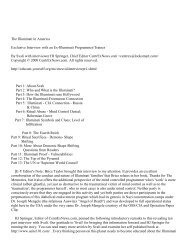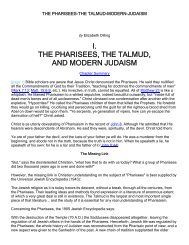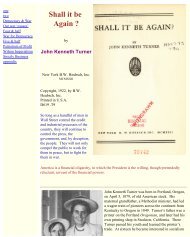Create successful ePaper yourself
Turn your PDF publications into a flip-book with our unique Google optimized e-Paper software.
<strong>Fascist</strong> <strong>Spectacle</strong> http://content.cdlib.org/xtf/view?docId=ft18700444&chunk.id=0&doc.v...<br />
upholding the strength and power of a country. If, as the syndicalists believed, the value of the nation<br />
overshadowed any other value, then opposing sides in labor disputes should strive toward reconciling<br />
their conflicts when these might negatively affect national interests. In contrast to the socialists, who<br />
had protested the world conflict in the name of proletarian internationalism, the syndicalists<br />
proclaimed their loyalty to the fatherland. In June 1918, as an alternative to the socialist organizations<br />
of workers, they founded their own confederation, the Unione Italiana del Lavoro (UIL).<br />
In 1919, when he founded the Fasci Italiani di Combattimento, Mussolini supported UIL, as he had<br />
previously done from the columns of Il Popolo d'Italia . During the following two years, the relations<br />
between the fascists and UIL underwent several problems: some syndicalist leaders refused to align<br />
with Mussolini's movement and thus lose autonomy, and the fascists<br />
― 130 ―<br />
took an increasingly antiworker position. [45] But when on January 1922 fascists and syndicalists<br />
promoted the National Confederation of Syndicate Corporations under the auspices of the newly<br />
formed <strong>Fascist</strong> Party, the organization inherited much of the originary impulse at the basis of national<br />
syndicalism. [46] Edmondo Rossoni, previously the head of UIL and an opponent of syndicalism's<br />
politicization, came to be elected general secretary of the new confederation. Still vowing antisocialism<br />
and anti-Catholicism, the organization included five national corporations upon which all provincial<br />
sections depended. As in the original formula of the revolutionary syndicalists, the corporations were<br />
supposed to bring together all professional activities that identified their own "moral and economic<br />
elevation . . . with the indispensable duty of the citizen towards the Nation." [47] Thus, Article 4 of the<br />
corporations' principles proclaimed: "The nation—considered a superior synthesis of all material and<br />
spiritual values of the race—is above individuals, groups and classes. Individuals, groups and classes<br />
are instruments, made use of by the nation to gain a better position. The interests of individuals and<br />
of groups acquire legitimacy on condition that they are maintained within the frame of the superior<br />
national interests." [48] The corporations rejected class struggle and replaced it with collaboration<br />
between producers; labor conflicts needed to be overcome through cooperation. The national solidarity<br />
thus established would further the primary goal of the development of production and benefit the<br />
whole country, the fatherland. Hence, at the first congress of the National Confederation of Syndicate<br />
Corporations, in June 1922, Mussolini affirmed that the fascist syndicates would not replace the<br />
socialist workers' organizations. [49] They would not foster hatred and promote conflict, because the<br />
resolution of workers' struggles guaranteed the grandeur of the nation through social order, class<br />
collaboration, and maximum productivity. [50] National syndicates would still sponsor workers' claims<br />
but would do so within the limits set by the primary pursuit of the nation's successful growth.<br />
Between 1922 and 1926, during Mussolini's ascent to power and the regime's totalitarian turn,<br />
fascist syndicalism evolved. [51] Through a series of violent acts, laws, pacts, and decrees, it<br />
preempted the existence of other syndicates—via the elimination of socialist labor organizations and<br />
the marginalization of Catholic ones—and became the exclusive representative of workers. At the<br />
same time, relations between the National Confederation of <strong>Fascist</strong> Syndicates and the <strong>Fascist</strong> Party<br />
became tighter, and Mussolini's government continued a policy that overwhelmingly favored the<br />
interests of the industrial classes over those of workers. An important event in this transitional phase<br />
was the Pact of Palazzo Vidoni of October 2, 1925, in which<br />
― 131 ―<br />
delegates of the General Confederation of Industry and of the National Confederation of <strong>Fascist</strong><br />
Syndicates recognized each other as the only official representatives of, respectively, the industrialists'<br />
and the workers' interests. [52] The syndical law of April 3, 1926 (Law Number 563), drafted under the<br />
direction of Minister of Justice Alfredo Rocco, legally authorized the fascist syndicates' monopoly over<br />
worker representation. The law ruled that only one association of workers and one of employers would<br />
be recognized for each branch of production (and such recognition was only extended to fascist<br />
organizations), and these associations would be supervised and controlled by the state. [53] The law<br />
also eliminated the right to strikes and lockouts, and it instituted labor courts as a system of<br />
arbitration in case the involved parties failed to reach agreement. Furthermore, the statute proposed<br />
the future creation of provincial corporations that would connect employers, workers, and experts<br />
involved in the same field of production. [54] The idea of a fascist corporative system began to take<br />
shape. [55] On July 2, 1926, a royal decree established the Ministry of Corporations, charged with<br />
overseeing syndicate activity and corporate organizations. On April 21, 1927, the Labor Charter<br />
consecrated the main principles upon which the system of corporations was supposed to build. The<br />
charter emphasized class collaboration and the preeminence of private initiative over state intervention<br />
78 of 199 7/11/2006 12:54 AM









